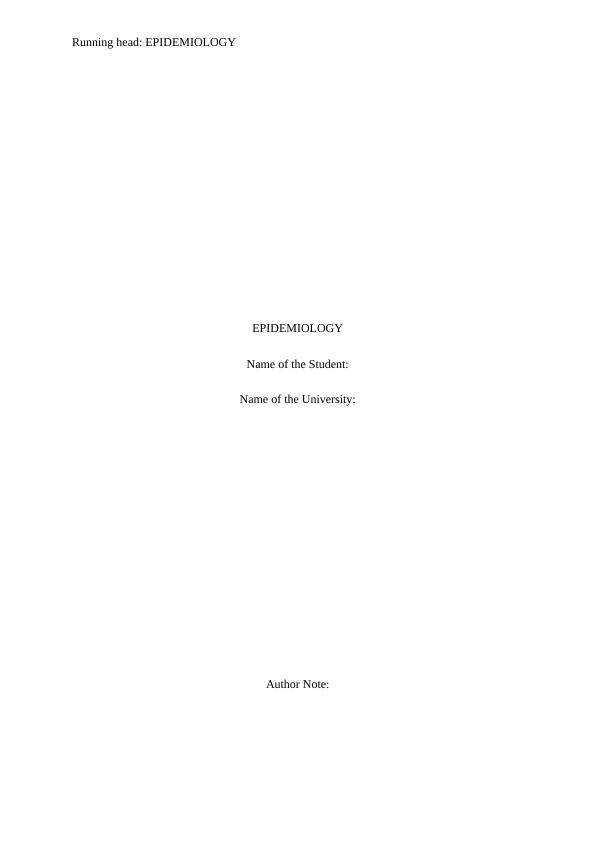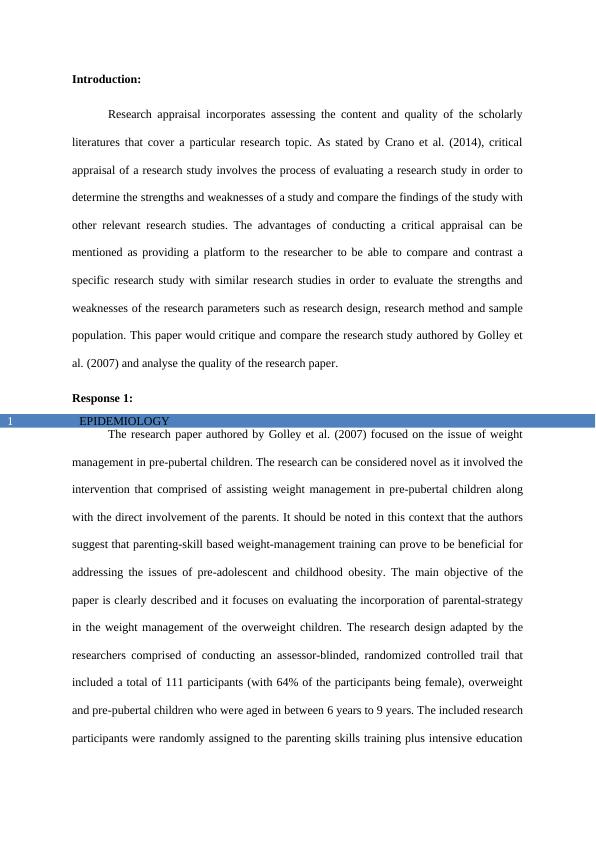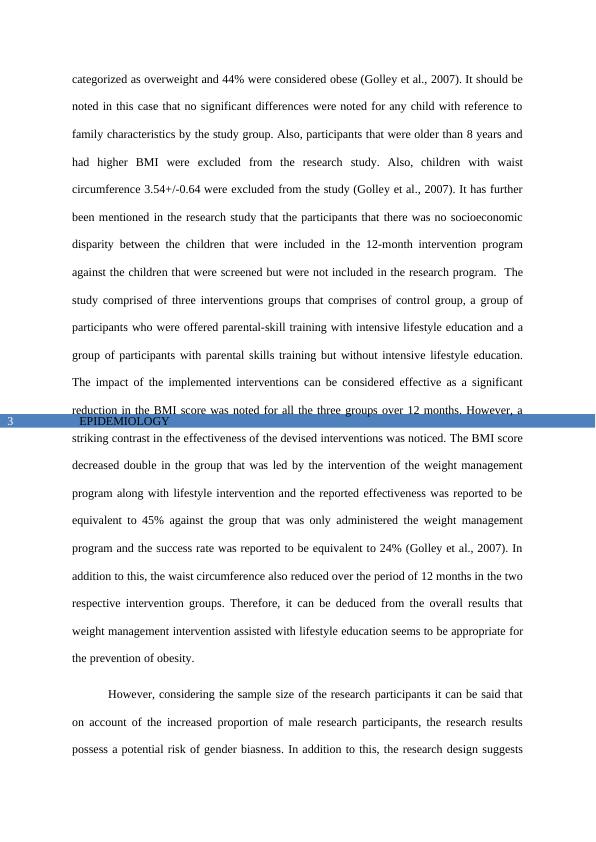Critical Appraisal of a Research Study on Weight Management in Pre-pubertal Children
Added on 2023-01-20
11 Pages3286 Words79 Views
Running head: EPIDEMIOLOGY
EPIDEMIOLOGY
Name of the Student:
Name of the University:
Author Note:
EPIDEMIOLOGY
Name of the Student:
Name of the University:
Author Note:

EPIDEMIOLOGY1
Introduction:
Research appraisal incorporates assessing the content and quality of the scholarly
literatures that cover a particular research topic. As stated by Crano et al. (2014), critical
appraisal of a research study involves the process of evaluating a research study in order to
determine the strengths and weaknesses of a study and compare the findings of the study with
other relevant research studies. The advantages of conducting a critical appraisal can be
mentioned as providing a platform to the researcher to be able to compare and contrast a
specific research study with similar research studies in order to evaluate the strengths and
weaknesses of the research parameters such as research design, research method and sample
population. This paper would critique and compare the research study authored by Golley et
al. (2007) and analyse the quality of the research paper.
Response 1:
The research paper authored by Golley et al. (2007) focused on the issue of weight
management in pre-pubertal children. The research can be considered novel as it involved the
intervention that comprised of assisting weight management in pre-pubertal children along
with the direct involvement of the parents. It should be noted in this context that the authors
suggest that parenting-skill based weight-management training can prove to be beneficial for
addressing the issues of pre-adolescent and childhood obesity. The main objective of the
paper is clearly described and it focuses on evaluating the incorporation of parental-strategy
in the weight management of the overweight children. The research design adapted by the
researchers comprised of conducting an assessor-blinded, randomized controlled trail that
included a total of 111 participants (with 64% of the participants being female), overweight
and pre-pubertal children who were aged in between 6 years to 9 years. The included research
participants were randomly assigned to the parenting skills training plus intensive education
Introduction:
Research appraisal incorporates assessing the content and quality of the scholarly
literatures that cover a particular research topic. As stated by Crano et al. (2014), critical
appraisal of a research study involves the process of evaluating a research study in order to
determine the strengths and weaknesses of a study and compare the findings of the study with
other relevant research studies. The advantages of conducting a critical appraisal can be
mentioned as providing a platform to the researcher to be able to compare and contrast a
specific research study with similar research studies in order to evaluate the strengths and
weaknesses of the research parameters such as research design, research method and sample
population. This paper would critique and compare the research study authored by Golley et
al. (2007) and analyse the quality of the research paper.
Response 1:
The research paper authored by Golley et al. (2007) focused on the issue of weight
management in pre-pubertal children. The research can be considered novel as it involved the
intervention that comprised of assisting weight management in pre-pubertal children along
with the direct involvement of the parents. It should be noted in this context that the authors
suggest that parenting-skill based weight-management training can prove to be beneficial for
addressing the issues of pre-adolescent and childhood obesity. The main objective of the
paper is clearly described and it focuses on evaluating the incorporation of parental-strategy
in the weight management of the overweight children. The research design adapted by the
researchers comprised of conducting an assessor-blinded, randomized controlled trail that
included a total of 111 participants (with 64% of the participants being female), overweight
and pre-pubertal children who were aged in between 6 years to 9 years. The included research
participants were randomly assigned to the parenting skills training plus intensive education

EPIDEMIOLOGY2
and parental skills training program for a period of 12 months. It should be mentioned in this
context that the height, waist circumference as well as metabolic profile was accessed at an
interval of 6 months and 12 months in order to evaluate the effectiveness of the applied
interventions. The overall results suggested that the group of participants that were subjected
to parenting skills training in combination with intensive lifestyle education reported a
reduction in the BMI z score equivalent to 10% against the group of participants that was
treated with parenting skills training individually or wait-listing as a weight-loss intervention
individually which only reported a 5% reduction in the BMI score. In addition to this, it
should be noted that a reduction in the wait reduction was noticed in the two intervention
groups against the control group. The results also revealed a gender effect which suggests a
greater reduction in the BMI was reported in boys as against girls. Therefore, it can be
mentioned that the research study helped in establishing the findings that parental skills
training in combination with the promotion of a healthy lifestyle approach could help in
effective management of weight among children, specifically in boys. The research topic also
proves to be promising for future researchers to develop effective weight management
interventions for the prevention of obesity in children. In addition to this, it should also be
noted that the researchers have also suggested that future studies could focus on adiposity
reductions among the control groups and incorporate better methods to analyse primary
outcome, secondary outcome as well as gender sub-analysis.
Response 2:
The research participants comprised of 64% participants that were female and most of
them were 8 years and elder and were obese. In addition to this, 72% of the children belonged
to dual-parent families with a total of 98% of the parents who belonged to white ancestry.
The mean standard deviation for the SEIFA index of the relative advantage was 997+/-73
against the South Australian mean of 960. In addition to this, 34% of the parents were
and parental skills training program for a period of 12 months. It should be mentioned in this
context that the height, waist circumference as well as metabolic profile was accessed at an
interval of 6 months and 12 months in order to evaluate the effectiveness of the applied
interventions. The overall results suggested that the group of participants that were subjected
to parenting skills training in combination with intensive lifestyle education reported a
reduction in the BMI z score equivalent to 10% against the group of participants that was
treated with parenting skills training individually or wait-listing as a weight-loss intervention
individually which only reported a 5% reduction in the BMI score. In addition to this, it
should be noted that a reduction in the wait reduction was noticed in the two intervention
groups against the control group. The results also revealed a gender effect which suggests a
greater reduction in the BMI was reported in boys as against girls. Therefore, it can be
mentioned that the research study helped in establishing the findings that parental skills
training in combination with the promotion of a healthy lifestyle approach could help in
effective management of weight among children, specifically in boys. The research topic also
proves to be promising for future researchers to develop effective weight management
interventions for the prevention of obesity in children. In addition to this, it should also be
noted that the researchers have also suggested that future studies could focus on adiposity
reductions among the control groups and incorporate better methods to analyse primary
outcome, secondary outcome as well as gender sub-analysis.
Response 2:
The research participants comprised of 64% participants that were female and most of
them were 8 years and elder and were obese. In addition to this, 72% of the children belonged
to dual-parent families with a total of 98% of the parents who belonged to white ancestry.
The mean standard deviation for the SEIFA index of the relative advantage was 997+/-73
against the South Australian mean of 960. In addition to this, 34% of the parents were

EPIDEMIOLOGY3
categorized as overweight and 44% were considered obese (Golley et al., 2007). It should be
noted in this case that no significant differences were noted for any child with reference to
family characteristics by the study group. Also, participants that were older than 8 years and
had higher BMI were excluded from the research study. Also, children with waist
circumference 3.54+/-0.64 were excluded from the study (Golley et al., 2007). It has further
been mentioned in the research study that the participants that there was no socioeconomic
disparity between the children that were included in the 12-month intervention program
against the children that were screened but were not included in the research program. The
study comprised of three interventions groups that comprises of control group, a group of
participants who were offered parental-skill training with intensive lifestyle education and a
group of participants with parental skills training but without intensive lifestyle education.
The impact of the implemented interventions can be considered effective as a significant
reduction in the BMI score was noted for all the three groups over 12 months. However, a
striking contrast in the effectiveness of the devised interventions was noticed. The BMI score
decreased double in the group that was led by the intervention of the weight management
program along with lifestyle intervention and the reported effectiveness was reported to be
equivalent to 45% against the group that was only administered the weight management
program and the success rate was reported to be equivalent to 24% (Golley et al., 2007). In
addition to this, the waist circumference also reduced over the period of 12 months in the two
respective intervention groups. Therefore, it can be deduced from the overall results that
weight management intervention assisted with lifestyle education seems to be appropriate for
the prevention of obesity.
However, considering the sample size of the research participants it can be said that
on account of the increased proportion of male research participants, the research results
possess a potential risk of gender biasness. In addition to this, the research design suggests
categorized as overweight and 44% were considered obese (Golley et al., 2007). It should be
noted in this case that no significant differences were noted for any child with reference to
family characteristics by the study group. Also, participants that were older than 8 years and
had higher BMI were excluded from the research study. Also, children with waist
circumference 3.54+/-0.64 were excluded from the study (Golley et al., 2007). It has further
been mentioned in the research study that the participants that there was no socioeconomic
disparity between the children that were included in the 12-month intervention program
against the children that were screened but were not included in the research program. The
study comprised of three interventions groups that comprises of control group, a group of
participants who were offered parental-skill training with intensive lifestyle education and a
group of participants with parental skills training but without intensive lifestyle education.
The impact of the implemented interventions can be considered effective as a significant
reduction in the BMI score was noted for all the three groups over 12 months. However, a
striking contrast in the effectiveness of the devised interventions was noticed. The BMI score
decreased double in the group that was led by the intervention of the weight management
program along with lifestyle intervention and the reported effectiveness was reported to be
equivalent to 45% against the group that was only administered the weight management
program and the success rate was reported to be equivalent to 24% (Golley et al., 2007). In
addition to this, the waist circumference also reduced over the period of 12 months in the two
respective intervention groups. Therefore, it can be deduced from the overall results that
weight management intervention assisted with lifestyle education seems to be appropriate for
the prevention of obesity.
However, considering the sample size of the research participants it can be said that
on account of the increased proportion of male research participants, the research results
possess a potential risk of gender biasness. In addition to this, the research design suggests

End of preview
Want to access all the pages? Upload your documents or become a member.
Related Documents
Epidemiology: Critical Appraisallg...
|17
|4222
|82
Essay on Obesity in Children and new Interventionslg...
|9
|3251
|58
Appraising the Effectiveness of a Parent-Led Weight Management Program for Childrenlg...
|11
|2673
|241
NURS 1033 - Articles on Health Professionalslg...
|11
|3255
|34
Effect of Antimicrobial Resistance on Development of Obesity in Children - Critical Appraisal Essaylg...
|13
|4005
|492